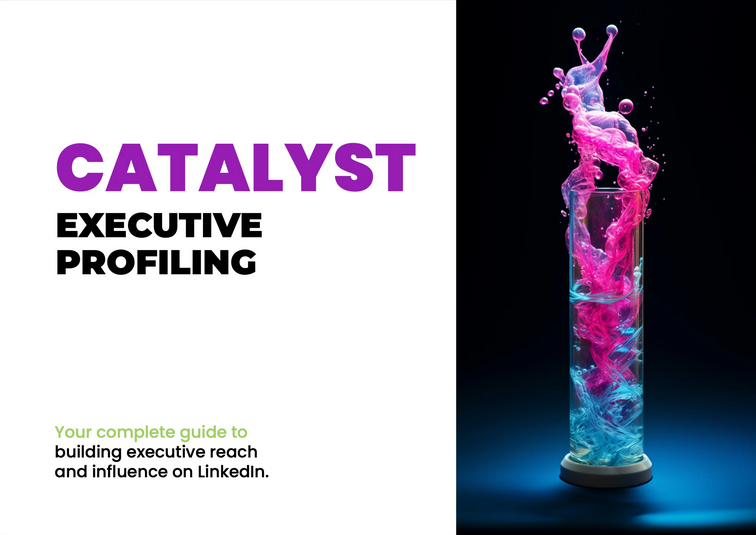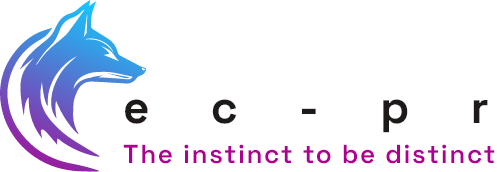
Personal branding for B2B tech c-suite executives: your questions answered
Personal branding has become a much-lauded concept embraced by solopreneurs like Lea Turner and successful CEOs like Steven Bartlett. But is personal branding an appropriate strategy for c-suite executives in ambitious B2B tech businesses? In this article, we explore the true nature of a personal brand and the role it can play in accelerating business performance, as well as considering whether you are the right person to adopt a personal brand strategy.
Your questions answered
- What is a personal brand?
- What’s the difference between personal branding and social media influencers?
- How do c-suite executives with personal branding stand out?
- What difference can personal branding make to the bottom line?
- Common myths about personal branding – we debunk them!
- How do you craft your personal brand? 10 simple steps
- Take the test: 5 questions to discover if personal branding is right for your c-suite
What is a personal brand?
A personal brand is the unique combination of skills, experiences and personality you want the world to see. It’s the telling of your story and how it reflects your conduct, behaviour, spoken and unspoken words and attitudes. For c-suite executives in B2B tech, it’s about crafting a professional image that resonates with your target audience – be it customers, partners, investors or potential employees.
Think of it as your professional reputation, carefully cultivated and consistently presented across various platforms and interactions. It’s not just about what you say about yourself, but also how others perceive and describe you when you’re not in the room.
Why personal branding should not be confused with social media influencers
It’s crucial to dispel a common misconception about personal branding. Many people associate personal brands solely with social media influencers or public figures who have a large online following. However, this view is far too narrow and misses the true essence of personal branding, especially in the context of B2B technology leadership. For many leaders there is a sense in which they appreciate the opportunity to share their knowledge with younger generations who are earlier in their career. Some even suggest it’s an opportunity to invest in the future.
A personal brand is not the exclusive domain of social media personalities or public activists. Instead, it’s a professional asset that can be cultivated by anyone, including c-suite executives in the B2B tech sector. At its core, your personal brand is about establishing yourself as a recognised expert in a specific subject area or field.
How do c-suite executives with personal branding stand out?
For senior leaders in B2B tech, your personal brand revolves around the particular domain or set of skills in which you want to be considered a de facto authority. This could be anything from artificial intelligence in healthcare to sustainable practices in cloud computing or innovative approaches to cybersecurity in financial services. Your personal brand is the culmination of your expertise, experiences and insights in your chosen area, communicated consistently across various professional platforms and interactions.
By focusing on your area of expertise, you can build a personal brand that positions you as a thought leader in your industry, regardless of your social media following or public profile. This approach to personal branding is about depth of knowledge and influence within your professional sphere, rather than breadth of popularity across general audiences.
What difference does personal branding in B2B tech make to the bottom line?
A strong personal brand can be a true game-changer. It builds trust and credibility, establishing you as a thought leader in your industry. This is particularly crucial in B2B environments where decisions often involve significant investments and long-term partnerships.
Your personal brand as a c-suite executive doesn’t exist in isolation; it’s intrinsically linked to your company’s brand. A positive personal brand can elevate the entire organisation’s reputation, acting as a powerful marketing tool. It can attract new business opportunities, forge valuable partnerships and even help recruit top talent who want to work with recognised industry leaders.
In the crowded B2B tech space, a unique personal brand helps you stand out from competitors. It gives you a voice and a platform to share your vision, insights and expertise. This differentiation can be crucial in winning deals, securing investments, or gaining media attention for your company.
Moreover, a well-established personal brand can be an asset in times of crisis. When challenges arise, a strong personal brand can act as a buffer, helping maintain stakeholder confidence and providing a foundation for effective communication.
Let’s debunk commons personal branding myths
Despite its importance, personal branding is often misunderstood. Let’s clear up some common misconceptions:
Firstly, a personal brand isn’t a façade or a false persona. Authenticity is key. Your brand should be a true reflection of who you are, not who you think others want you to be. It’s about highlighting your genuine strengths and values, not creating a fictional character.
Secondly, personal branding isn’t about constant self-promotion or bragging. It’s about consistently demonstrating your expertise and value through your work, your insights and your interactions with others.
Another myth is that personal branding is separate from your professional life. In reality, especially for c-suite executives, your personal brand should align closely with your company’s values and goals. It’s not about overshadowing your company, but about being a strong, visible leader within your organisation’s context.
Many people believe that once established, a personal brand can be set and forgotten. This couldn’t be further from the truth. Your personal brand should evolve with your career, your industry and the broader business landscape. It requires ongoing attention and refinement.
Lastly, personal branding isn’t just for job seekers or entrepreneurs, nor is it solely about social media presence. For c-suite executives in B2B tech, it’s a valuable tool for leadership and business growth, extending far beyond online platforms to encompass all professional interactions.
Your personal brand should evolve with your career, your industry and the broader business landscape. It requires ongoing attention and refinement.
How do you craft your personal brand?
10 steps of self-discovery and strategic communication
Developing a strong personal brand is a journey that combines introspection with strategic outward communication. Let’s break this process down into manageable steps:
1Begin with self-reflection
Take time to identify your strengths, values, passions, and the unique value you bring to your industry. Ask yourself: What sets you apart from other executives in your field? What are the core principles that guide your leadership style? What do you want to be known for?
2Define your audience
Consider who you want to reach and influence with your personal brand. In the B2B tech world, this might include potential clients, industry partners, investors, or even future employees. Understanding your audience will help you tailor your message effectively.
3Craft your core message
With a firm grasp on your niche and your audience, develop a clear, consistent message that reflects your expertise and aligns with your business’s mission. This message should be the thread that runs through all your professional communications.
4Choose your platforms wisely
While LinkedIn is often a go-to for B2B professionals, don’t overlook the value of industry conferences, trade publications or even a personal blog. The key is to be where your target audience is most active and engaged.
5Create and curate content
Share valuable insights, thought leadership pieces and industry analyses regularly. This doesn’t mean you need to produce novel content constantly; sharing and commenting on relevant industry news can be just as effective in establishing your expertise.
6Network strategically
Build relationships with other industry leaders, both online and offline. Engage in meaningful discussions and don’t shy away from respectful debates. These interactions not only expand your influence but also provide valuable insights and opportunities.
7Seek speaking opportunities
Look for chances to present at conferences, participate in panel discussions, or host webinars. These platforms allow you to showcase your expertise to a broader audience and establish yourself as a thought leader in your field.
8Align with your company brand
As you develop your personal brand, always ensure it complements and enhances your company’s brand. As a c-suite executive, your personal brand and your company’s brand should be in harmony, each strengthening the other.
9Be consistent and authentic
Ensure your brand is consistently represented across all platforms and interactions. Remember, authenticity is key – your brand should be a true reflection of who you are, not who you think others want you to be.
10Monitor and evolve
Regularly assess the impact of your branding efforts and be prepared to adjust your strategy as needed. Your personal brand should evolve with your career, your industry and the broader business landscape.
Remember, building a strong personal brand takes time and consistent effort. It’s not about becoming famous in the traditional sense, but about being known and respected within your specific industry. It’s about showcasing your authentic self and the value you bring to your field.
By following these steps and approaching personal branding strategically, you can create a personal brand that not only elevates your professional standing but also contributes significantly to your company’s success in the competitive B2B technology landscape. It’s an investment in your professional future and your company’s reputation, one that can yield substantial returns in the dynamic world of B2B tech.
What about networking?
Networking, both online and offline, is another crucial aspect of personal branding. Build relationships with other industry leaders, engage in meaningful discussions, and don’t shy away from respectful debates. These interactions not only expand your influence but also provide valuable insights and opportunities.
Public speaking can significantly boost your personal brand. Seek out opportunities to present at conferences, participate in panel discussions, or host webinars. These platforms allow you to showcase your expertise to a broader audience and establish yourself as a thought leader in your field.
As you develop your personal brand, always ensure it complements and enhances your company’s brand. As a c-suite executive, your personal brand and your company’s brand should be in harmony, each strengthening the other.
Is a personal brand strategy right for you?
Before embarking on a personal branding journey, you must assess whether this strategy aligns with your professional goals and organisational needs. Here are five essential questions to help you determine if developing a personal brand should be a priority:
Five key questions for senior leaders
1. What are your long-term career aspirations and how might a strong personal brand support these goals?
Consider where you want to be in five or ten years. Are you aiming for a CEO position, looking to transition to a different sector, or perhaps planning to join corporate boards? A well-crafted personal brand can pave the way for these opportunities by establishing your credibility and expertise well in advance.
2. How visible is your company in the industry and could your personal brand help elevate its profile?
If your organisation is lesser-known or facing tough competition, your personal brand could serve as a powerful differentiator. Your thought leadership could bring attention to your company’s innovations and values, potentially opening doors to new partnerships or customer relationships.
3. Are there gaps in your industry’s thought leadership that you’re uniquely positioned to fill?
Reflect on your specialist knowledge and experiences. Is there a perspective or area of expertise currently underrepresented in your industry’s discourse? Your personal brand could be the vehicle to address these gaps, positioning you as a pioneer and go-to expert in these areas.
4. How comfortable are you with public speaking writing, and engaging on social media platforms?
Building a personal brand often involves these activities. While you can develop these skills over time, it’s important to consider your willingness to engage in these areas. A personal brand strategy could be a natural fit if you’re enthusiastic about sharing your ideas and insights publicly.
5. Do you have the time and resources to consistently maintain and evolve your personal brand?
Developing a personal brand is not a one-time effort; it requires ongoing attention and refinement. Consider whether you can commit to regularly creating content, engaging with your network and staying abreast of industry trends. If not, you might need to evaluate how to integrate personal branding activities into your current workflow or consider getting support from your marketing team or external consultants.
By honestly answering these questions, you can gain clarity on whether pursuing a personal brand strategy would benefit you and your organisation. Remember, a personal brand is a powerful tool, but it’s most effective when it aligns with your authentic self and your professional objectives.
In conclusion, for c-suite executives in B2B tech companies, a well-crafted personal brand can be a powerful tool for driving personal and organisational success. It’s an investment in your professional future and your company’s reputation. By understanding what a personal brand truly is, dispelling common myths and approaching its development strategically, you can create a personal brand that not only elevates your professional standing but also contributes significantly to your company’s success in the competitive B2B technology landscape.
To get professional help with personal branding for your c-suite, we have a proven approach, please see our Personal Branding Services for leaders in B2B tech.

Discover how we use LinkedIn to grow influence
Our proven, white glove approach to building senior executive reach and influence on LinkedIn.
Our insights
Subscribe to our updates
Stay up to date with the latest insights, case studies and PR guides.

